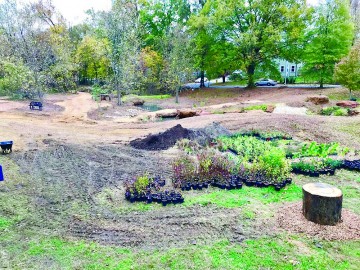Return to Eden
The woods behind St. Luke’s Church in Eastport looked pretty natural. But if you’d trained your eye to nature’s ways, you saw a tangle of invasive plants strangling the native trees and shrubs. Deeper in, a 42-inch wide underground pipe drained stormwater along with sediment, toxins, pet waste and other unpleasant things from 28 surrounding acres directly into Back Creek.
Not so pretty. Or natural.
“One of our core values as a congregation is caring for God’s creation,” church pastor Diana Carroll told Bay Weekly.
The congregation made a choice. Instead of clearing its woods for condo development, it restored the land for the benefit of current and future generations.
Inspired by the Anne Arundel County’s Master Watershed Stewards Program, parishioner Betsy Love and St. Luke’s Church embarked on an ambitious path to restore the natural stream that had long been buried in a pipe. A second goal was to make the woodland a haven for native plants and wildlife, as well as for environmental education.
After four years of planning, applying for grants and getting permits, the St. Luke’s woods are a renewed landscape built around eight best stormwater management practices. A series of step pools and weirs naturally conveys water downhill while slowing and spreading it out. The slowed flow replenishes the aquifer while cleaning the water as it seeps through the stream channel. The native tidal marsh has returned, and a now-living living shoreline stabilizes eroding banks. Spawning fish and other aquatic species are returning.
Benefits have reached beyond church property to the city of Annapolis, which gains Total Maximum Daily Load reduction credits to help meet its share of Chesapeake Bay Program’s blueprint for restoration.
This new Eden has become an inspiring example. First, the woods will make an environmental education campus for schools teaching environmental literacy.
Second, the restoration teaches lessons to other communities seeking to restore their share of nature. Watershed Stewards Academy Restoration Coordinator Suzanne Etgen summarized these lessons: think big, don’t give up and build relationships.

A remarkable exercise of patience, persistence, enthusiasm and technical expertise made project dreams a reality. What at first appeared to be impossibly ambitious for a small congregation with a little over 100 members, was realized by enlisting many partners and more than 1,000 volunteers, who removed invasives and installed new native plants.
The Anne Arundel County Watershed Stewards Academy helped connect the dots to move from concept to construction. Securing more than $1 million in project funding was only one challenge. Navigating the local, state, and federal regulatory maze was even more daunting, as the permitting system is designed more to control development than to encourage restoration projects. Project leader Love observed that the permitting process was among the Top 10 not for the faint of heart.
Winning a big grant from Maryland’s Chesapeake and Atlantic Coastal Bays Trust Fund, (supported with income from fuel and rental car taxes) would not have been possible without endorsements and funding support from lots of other partners. Local businesses, conservation organizations and churches all contributed funds and documented the kind of community support a successful grant application takes.
Collegial as it sounds in retrospect, getting to consensus was daunting all along the way. In spite of strong public support, a few neighbors were skeptical, concerned about increased sedimentation, mosquitos, tree removal, public access and longterm maintenance. Constant communication brought people together, anticipating and reducing opposition.
Now, it’s hard to argue with improved quality of life the St. Luke’s project has brought to the community. It has improved not only the water but also the neighborhood. Doing all that has educated a new generation of environmental stewards. St. Luke’s has inspired at least three other stream restoration initiatives on Back Creek and is a model for what can be done throughout the watershed.
Read Bay Weekly’s earlier story on this project at www.bayweekly.com/holy-waters. Follow the project on Facebook: www.facebook.com/restorationofnature/
